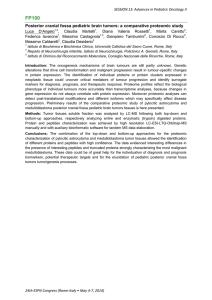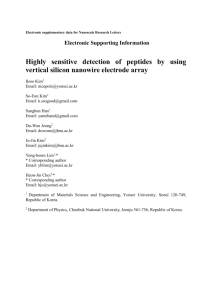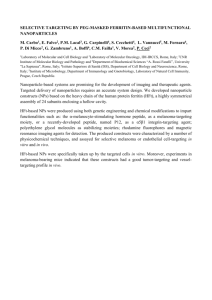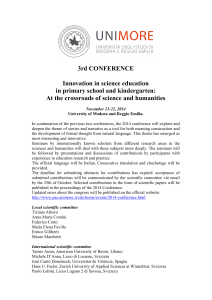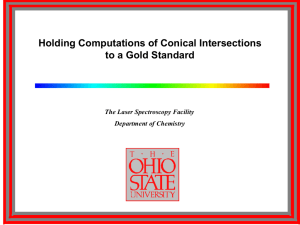Protein-surface interactions: insights from atomistic
advertisement
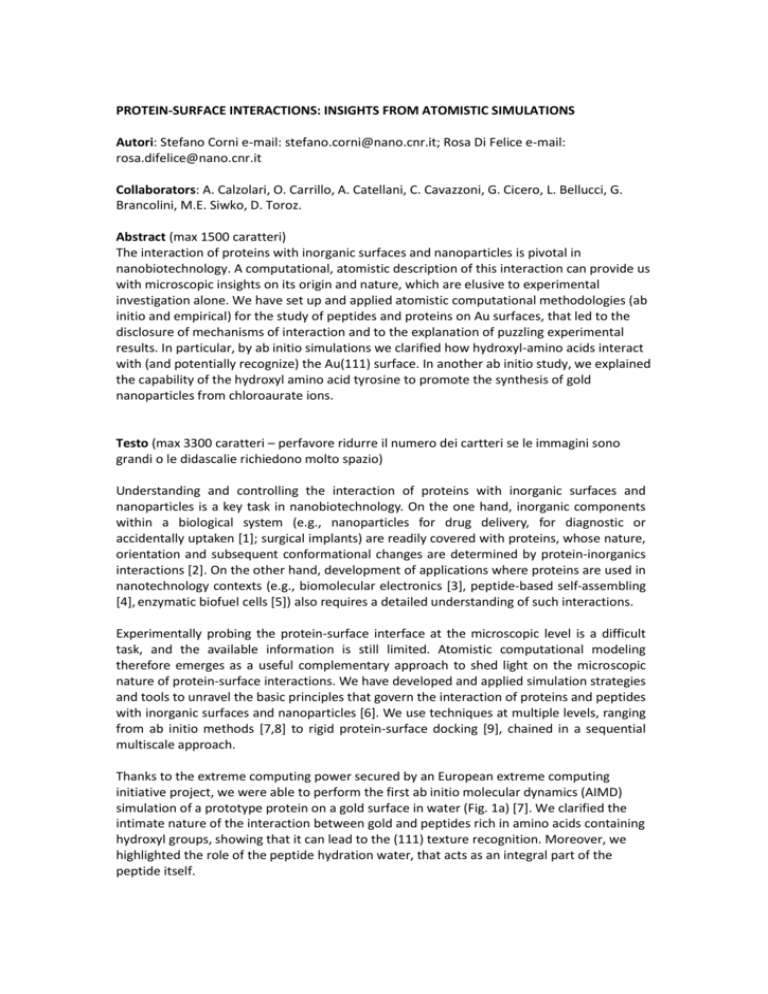
PROTEIN-SURFACE INTERACTIONS: INSIGHTS FROM ATOMISTIC SIMULATIONS Autori: Stefano Corni e-mail: stefano.corni@nano.cnr.it; Rosa Di Felice e-mail: rosa.difelice@nano.cnr.it Collaborators: A. Calzolari, O. Carrillo, A. Catellani, C. Cavazzoni, G. Cicero, L. Bellucci, G. Brancolini, M.E. Siwko, D. Toroz. Abstract (max 1500 caratteri) The interaction of proteins with inorganic surfaces and nanoparticles is pivotal in nanobiotechnology. A computational, atomistic description of this interaction can provide us with microscopic insights on its origin and nature, which are elusive to experimental investigation alone. We have set up and applied atomistic computational methodologies (ab initio and empirical) for the study of peptides and proteins on Au surfaces, that led to the disclosure of mechanisms of interaction and to the explanation of puzzling experimental results. In particular, by ab initio simulations we clarified how hydroxyl-amino acids interact with (and potentially recognize) the Au(111) surface. In another ab initio study, we explained the capability of the hydroxyl amino acid tyrosine to promote the synthesis of gold nanoparticles from chloroaurate ions. Testo (max 3300 caratteri – perfavore ridurre il numero dei cartteri se le immagini sono grandi o le didascalie richiedono molto spazio) Understanding and controlling the interaction of proteins with inorganic surfaces and nanoparticles is a key task in nanobiotechnology. On the one hand, inorganic components within a biological system (e.g., nanoparticles for drug delivery, for diagnostic or accidentally uptaken [1]; surgical implants) are readily covered with proteins, whose nature, orientation and subsequent conformational changes are determined by protein-inorganics interactions [2]. On the other hand, development of applications where proteins are used in nanotechnology contexts (e.g., biomolecular electronics [3], peptide-based self-assembling [4], enzymatic biofuel cells [5]) also requires a detailed understanding of such interactions. Experimentally probing the protein-surface interface at the microscopic level is a difficult task, and the available information is still limited. Atomistic computational modeling therefore emerges as a useful complementary approach to shed light on the microscopic nature of protein-surface interactions. We have developed and applied simulation strategies and tools to unravel the basic principles that govern the interaction of proteins and peptides with inorganic surfaces and nanoparticles [6]. We use techniques at multiple levels, ranging from ab initio methods [7,8] to rigid protein-surface docking [9], chained in a sequential multiscale approach. Thanks to the extreme computing power secured by an European extreme computing initiative project, we were able to perform the first ab initio molecular dynamics (AIMD) simulation of a prototype protein on a gold surface in water (Fig. 1a) [7]. We clarified the intimate nature of the interaction between gold and peptides rich in amino acids containing hydroxyl groups, showing that it can lead to the (111) texture recognition. Moreover, we highlighted the role of the peptide hydration water, that acts as an integral part of the peptide itself. We also investigated by ab initio calculations how peptides can control the synthesis of gold nanoparticles (Fig. 1b), explaining the puzzling differential behaviors of various hydroxyl amino acids in the early stages of nanoparticle formation [8]. The computational tools developed by us and by our international coworkers are freely available to the academic community [10]. (b) Figure 1. Ab initio simulations allowed explaining fundamental aspects of protein-surface and protein-nanoparticle interactions. Panel (a): Side-view of the protein-surface system investigated by AIMD simulations (peptide-Au and peptide-water interfaces are identified by rectangles). The 20 ps long simulation allowed to highlight the nature of the peptide-surface interaction and the geometrical preferences that follow [7]. Panel (b): charge density difference between the reduced and the oxidized forms of tyrosine (left) and serine (right) complexes with Au. Tyrosine and serine are both natural hydroxyl amino acids. Our ab initio calculations revealed why tyrosine is able to reduce gold much more effectively than serine [8]. [1] A. Nel, T. Xia, L. Mädler, and N. Li, Science 311, 622-7 (2006). [2] I. Lynch, K. A. Dawson, and S. Linse, Science’s STKE, pe14 (2006). [3] G. Maruccio, a. Biasco, P. Visconti, a. Bramanti, P. P. Pompa, F. Calabi, R. Cingolani, R. Rinaldi, S. Corni, R. Di Felice, E. Molinari, M. P. Verbeet, and G. W. Canters, Advanced Materials 17, 816-822 (2005). [4] M. Sarikaya, C. Tamerler, K. Y. J. Alex, K. Schulten, and F. Baneyx, Nature Materials 2, 577–585 (2003). [5] I. Willner, Y.-M. Yan, B. Willner, and R. Tel-Vered, Fuel Cells 9, 7-24 (2009). [6] R. Di Felice and S. Corni, J. Phys. Chem. Lett. 2, 1510–1519 (2011). [7] A. Calzolari, G. Cicero, C. Cavazzoni, R. D. Felice, A. Catellani, and S. Corni, J. Am. Chem. Soc. 132, 4790-4795 (2010). [8] D. Toroz, S. Corni, Nano Lett. 11, 1313-1318 (2011). [9] D. B. Kokh, S. Corni, P. Winn, M. Hoefling, K.-E. Gottschalk, and R. C. Wade, J. Chem. Th. Comput 6, 1753-1768 (2010). [10] http://www.s3.infm.it/prosurf/toolbox.html
